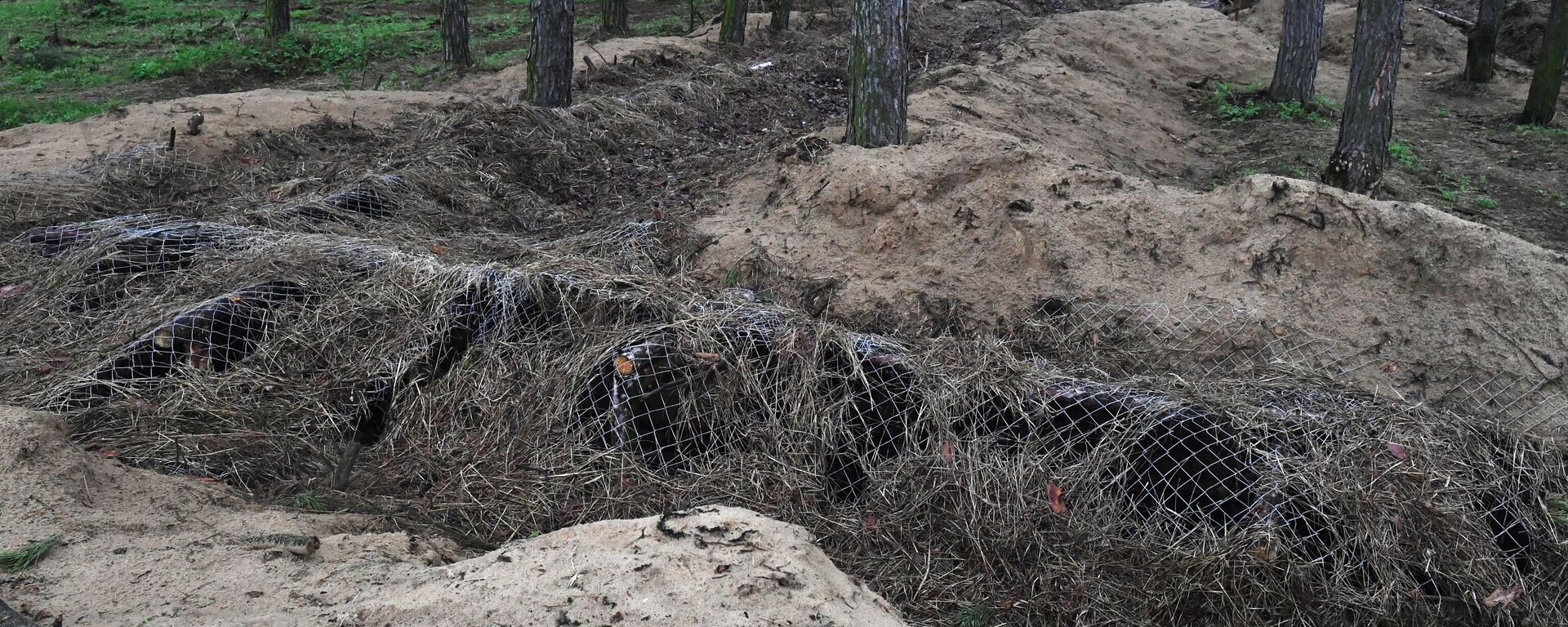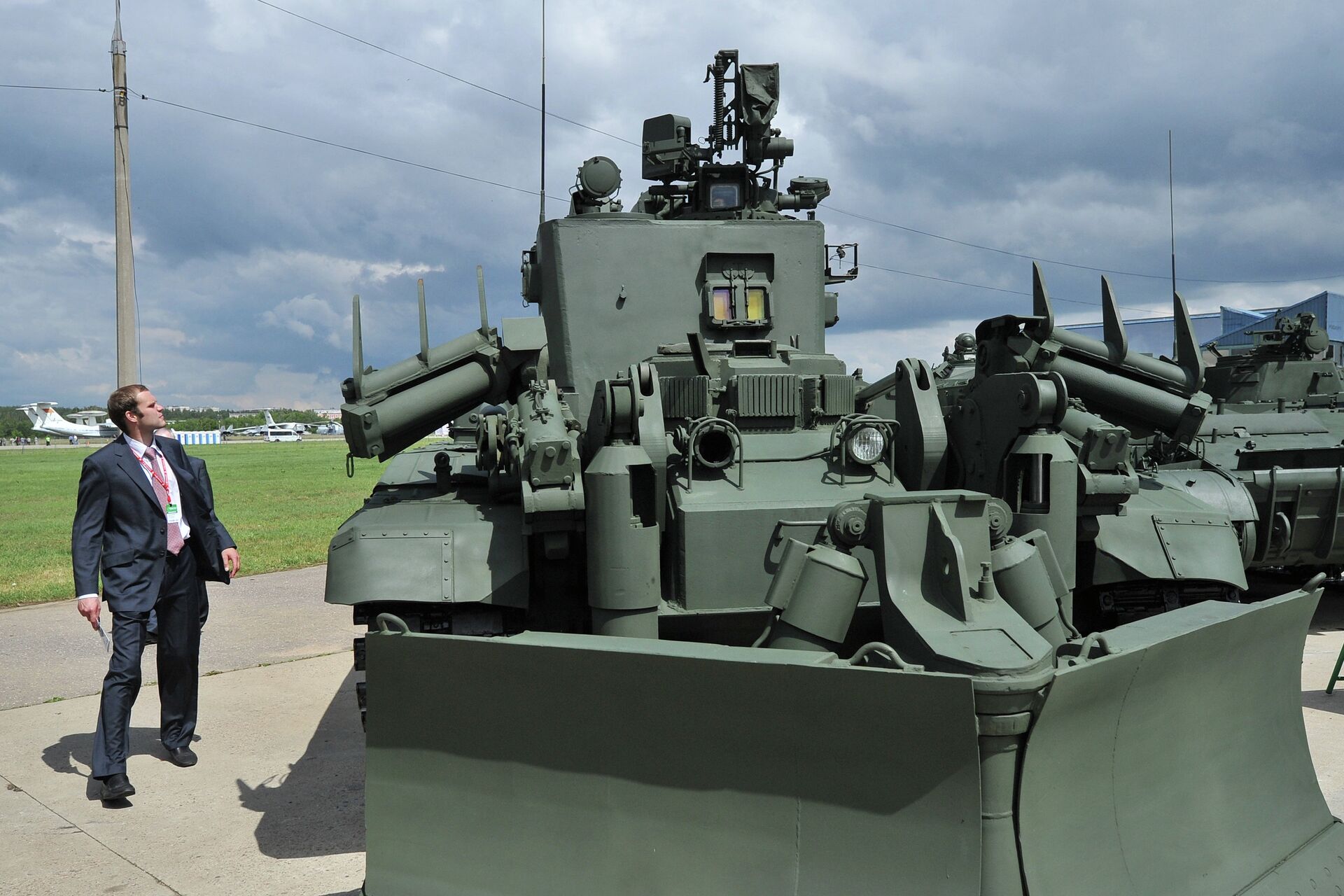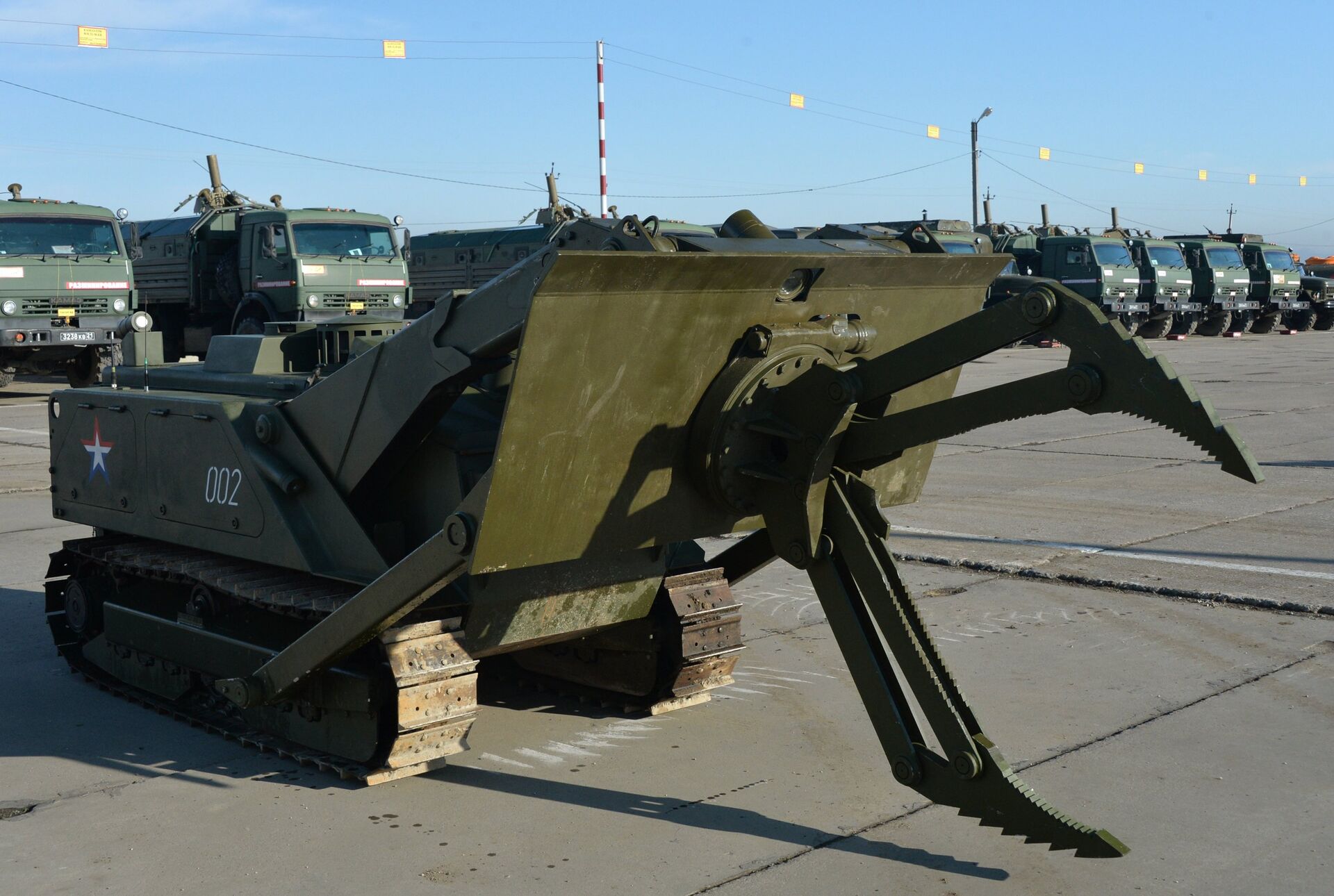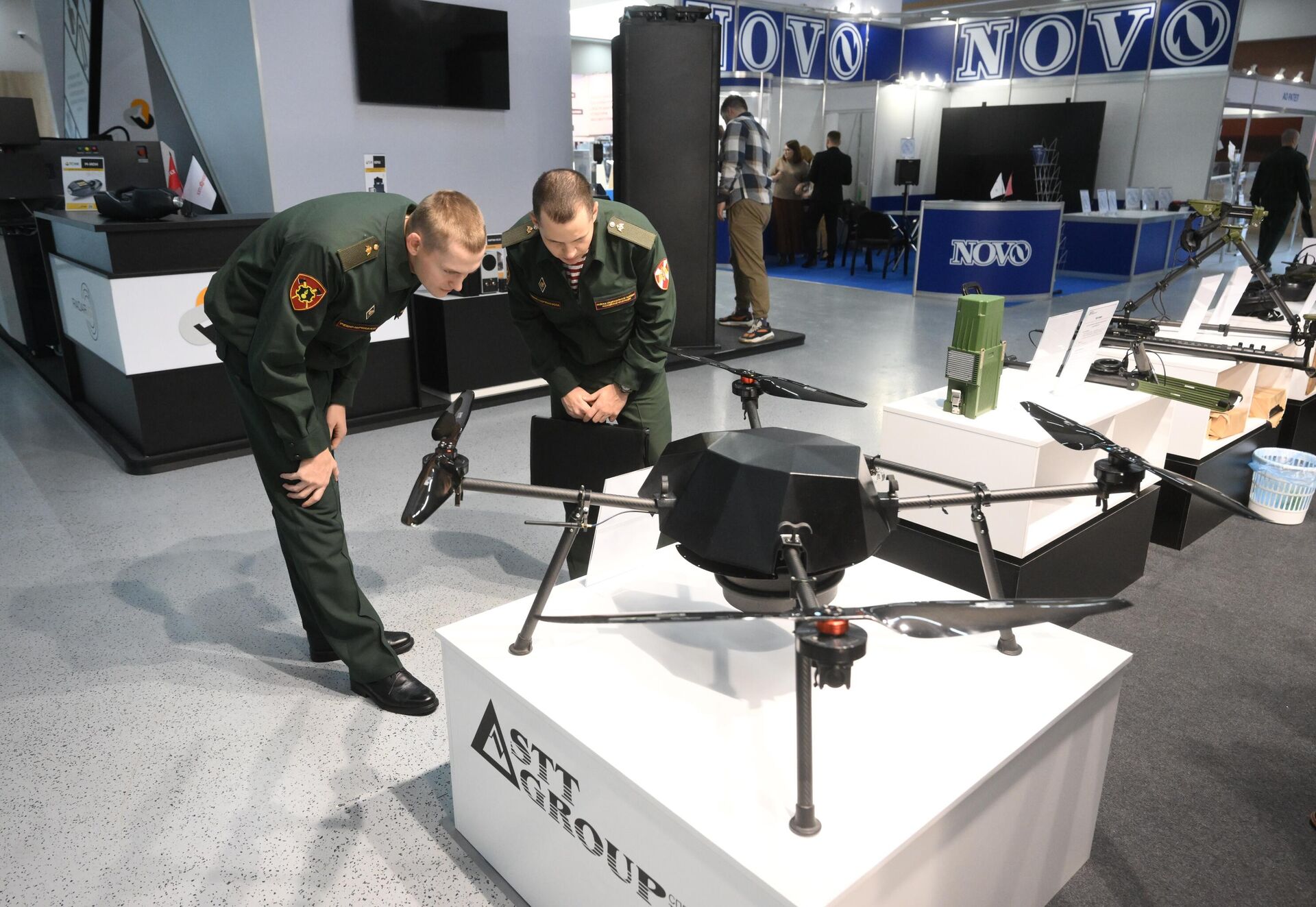https://sputnikglobe.com/20240123/from-line-charges-to-mine-clearing-robots-what-tools-do-russian-sappers-have-at-their-disposal-1116335954.html
From Line Charges to Mine-Clearing Robots: What Tools Do Russian Sappers Have at Their Disposal?
From Line Charges to Mine-Clearing Robots: What Tools Do Russian Sappers Have at Their Disposal?
Sputnik International
The Ukrainian crisis has demonstrated the importance of new technologies like drones and electronic warfare in the modern battlespace, but has also shown that much older equipment, including mines, hasn’t lost its significance. What tools do Russian sappers have at their disposal to defuse this deadly threat? Sputnik explores.
2024-01-23T16:46+0000
2024-01-23T16:46+0000
2024-01-25T10:32+0000
military
military & intelligence
russia
ukraine
donbass
russian defense ministry
nato
ur-83p
tnt
uran-6
https://cdn1.img.sputnikglobe.com/img/106093/37/1060933785_0:63:1200:738_1920x0_80_0_0_48ad40525e2c7e90665110b7145939f4.jpg
Russian sappers from the Western Group of Forces successfully breached Ukrainian minefields in several areas in the Kupyansk area in Kharkov region, the Russian Defense Ministry indicated Tuesday.“Engineering units from the 6th Combined Arms Army of the Western Group of Forces cleared passages in mine-explosive barriers in the Kupyansk area in the special operation zone,” the MoD said in a press statement.Sappers are continuing operations to clear the area of Ukrainian-laid mines sourced from old Soviet stocks, plus explosive objects which cannot be safely removed, according to the military.The MoD specified that in addition to minefields and mines left in trenches and dugouts by withdrawing Ukrainian troops, Russian forces have been forced to deal with an array of deadly ‘surprises’, such as booby-trapped radio equipment, small arms ammo magazines, and various personal belongings.Tools in Russian Sappers’ ToolboxDalny specified two pieces of equipment used by Russian sappers for remote demining operations – the UR-83P and UR-77 Meteorit mine-clearing vehicles.UR-83PThe UR-83P is a truck-portable, ground-launched, rocket-projected line-charge-based landmine clearing system, with its 22 plastic explosive-filled aluminized sectional line charges able to clear a path up to 115 meters long and 6 meters wide at a time.The 2.5 ton demining system, dubbed the Zmei Gorynich (literally ‘Snake Gorynych’ – the three-headed fire-spewing dragon of Russian fairytale lore), was first introduced with the Soviet military in 1983. The UR-83P’s operating principle is simple, with the system’s rocket propelling a long, snake-like line-charge packing up to 1,500 kg of TNT forward and exploding it, triggering all pressure-activated enemy mines and any other explosive devices nearby.The system is among the most potent mine-clearing devices in the Russian military, but cannot operate independently, since it does not guarantee the destruction of mines fitted with magnetic, double-tap, infrared and other non-contact-based sensors. Additional work by sappers is required to detect and defuse these mines.The UR-83P has a two-man crew.UR-77 MeteoritThe UR-77 Meteorite is another Soviet-designed mine-clearing device which the Russian military has made extensive use of in the special military operation zone. Fitted aboard a 2S1 Gvozdika tracked chassis, the system operates according to a principle similar to the UR-83P, with a rocket launcher projecting two mine-clearing line charges packed with TNT 83-93 meters forward, with explosive charges weighing between 665 and 725 kilograms (TNT or plastic explosives) detonating mines along a strip of land between six and 14 meters wide.The vehicle has a crew of two, and features a welded armored hull that enables operations close to the front, and protection against small arms fire and shell splinters.Does NATO Have an Equivalent?NATO’s equivalent to the UR-77 and the UR-83P is the US M58 Mine Clearing Line Charge (MICLIC), a canister-based, trailer-mounted system which appeared in the late 1980s and features a 794 kg C4 explosive charge placed in a flexible, 106 meter long hose and fired using a solid-propellant rocket, clearing a mined strip of land up to 100 meters long and 8 meters wide. The US delivered an undisclosed number of M58s to Ukraine in October 2022.Earlier this month, Russian media posted footage of an M58 being completely ripped apart after a small copter drone dropped a small bomb on its C4-carrying trailer.With line-based mine-clearing systems featuring no secondary armament of its own and carrying a powerful TNT or plastic explosive-based punch, keeping the equipment safe from drones and other projectiles in frontline areas is absolutely vital.IMR-3M Armored Obstacle Clearing VehicleIn situations where the wholesale destruction of a wide swath of land is not feasible or desired, but heavy demining operations are nevertheless necessary, Russian sappers turn to the IMR-3M (Russian acronym which stands for ‘Engineering Vehicle Obstacle-clearing 3 Modernized’). As the name suggests, this is a heavy engineering vehicle with mine-clearance capabilities.The 50 ton, two-man crewed vehicle rides on an armored T-90 tank chassis, and is based on a uniquely Soviet (and consequently Russian) tradition of tank-derived frontline specialized support vehicles which goes back to the late 1960s.First adopted into service with the Russian military in the late 1990s and receiving an upgrade to the 3M standard variant in the mid-2010s, the IMR-3M comes equipped with a universal grapple bucket for bulldozing, track-laying and grader work, and a universal mount for optional excavator bucket, grabber or ripper attachments. Key for sapper operations is an attachable mine trawl equipped with electromagnetic sensors for use against anti-track and anti-bottom mines equipped with both contact and non-contact magnetic fuses.The system can be fitted with a remote-controlled 12.7 mm machine gun installation for protection against ground and aerial targets, and a smoke screen-spewing exhaust system. The crewed capsule comes with radiation defense, with the onboard life support system enabling the crew to operate the vehicle for 72 hours at a time if necessary – including a water boiler and waste collection system.Sapper BotsWhen an even more surgical approach is required, such as in urban and heavily-populated areas, Russian sappers can depend on sapper robots, including both makeshift on-the-fly designs created by servicemen themselves and serial production models created specially for the needs of the Ukrainian battlefield.Last August, Russian engineers showed off the Pitbull and Partisan remote-controlled sapper bots. The former features an innovative triangular 12-wheel design for operations in rough terrain, an extendable robot claw arm and winch, while the latter is a more traditional multipurpose armored tracked combat platform. Along with sapper duties, both robots can be armed with an array of offensive capabilities, from machineguns to anti-tank missiles. These systems appear to be in the trials phase, and the timeline for their possible introduction in the special military operation zone remains unclear.The Uran-6 mine-clearing robot is another story, with the remote-controlled 6-ton heavy tracked drone tankette already successfully deployed on the battlefield for anti-personnel landmine, anti-tank mine and IED trawling use. Featuring between 4-5 onboard cameras, the Uran-6’s modular armored hull design features protection against blast fragments, and can be fitted with rotary tiller, rotating grabber arm, bulldozer blade or plough attachment.Rosoboronexport says the Uran-6 has a mine defusing effectiveness rate of up to 98 percent, with the system able survive blasts of 60+ kg of TNT point blank. The system can also clear debris and barbed wire obstacles and fill up trenches, create mounds and tow both civilian and heavy armored vehicles short distances. The remote control has a control and video transmission range from 300-800 meters.Uran-6 robots began to be deployed in the special operation zone in 2022, helping to demine the Donetsk People’s Republic city of Mariupol, and have reportedly undergone significant modernization based on their experience on the front lines, reportedly gaining enhanced armor protection and and an improved communication system.Russian sappers’ drone-based demining capabilities aren’t limited to ground equipment. Last October, developers announced the rollout of a new sapper drone called the Strekoza (lit. ‘Dragonfly’). The 12 kg system is designed to detect mines equipped with radioelectronic fuses at distances up to 30 meters away, and has a range up to 20 km and an endurance time up to 50 minutes.Once it picks up an enemy mine, the Strekoza can drop a TNT brick on the target to neutralize the threat. The system is equipped with a non-linear radio locator, camera, GPS module and data transmission channel.Smaller, off-the-shelf drones have been deployed for similar purposes, with the Russian military releasing footage earlier this week showing sappers appearing to use a customized quadcopter fitted with a brick of TNT to destroy a Ukrainian ammunition and explosives cache.Training and ExperienceNo amount of equipment or technological know-how can make up for the training and professionalism of human operators. The expertise of Russia’s Engineering Troops proved invaluable over the course of last year’s Ukrainian summer counteroffensive, not only in digging up and defusing enemy mines, but laying some 7,000 km-worth of landmines of their own, which, combined with air and artillery superiority, played a key role in blunting the advance.Sappers face an extremely difficult job in Ukraine, disarming everything from tiny, toy-like Lepestok (lit. ‘Petal’) antipersonnel mines dropped indiscriminately on Donbass settlements, to heavy converted thermobaric grenade-based mines that can vaporize everything living across a wide radius if not detected and disarmed in time.Last year, sappers taking part in the special military operation in the Donbass shared their experiences with Sputnik, saying their main encounters have included Soviet-vintage PMN-2 and TM-62 cylindrical anti-personnel and anti-tank pressure-, vibration- and magnet-triggered mines, OZM-72 canister-shaped fragmentation barrage mines, US-made M-86 anti-personnel trip line-triggered mines, and ML-7 and ML-8 series booby trap explosives.Ukrainian sappers are also known for their deceptive tactics, the serviceman recalled, saying that on one occasion while demining a TM-62 anti-tank mine, he found four booby-trap mines hidden underneath. “I was lucky I looked closely and noticed this. It’s a miracle that no one was hurt and the sappers cleared everything,” he said.Along with mines, it falls to Russia’s sapper units to perform controlled explosions of unexploded enemy shells – hundreds of thousands of which have been buried deep into the ground in and around populated settlements, farmlands and forests in the Donbass over the past decade.Sappers’ Importance Confirmed by Ukrainian CommandIn his now infamous op-ed for British business media last November in which he admitted that there would be no “deep and beautiful breakthrough” in Ukraine’s “stalemated” counteroffensive, Ukrainian Armed Forces Commander in Chief Valery Zaluzhny pointed to sapper equipment specifically as a key reason for the counteroffensive’s failure.“We need radar-like sensors that use invisible pulses of light to detect mines in the ground and smoke-projection systems to conceal the activities of our de-mining units. We can use jet engines from decommissioned aircraft, water cannons or cluster munitions to breach mine barriers without digging into the ground. New types of tunnel excavators, such as a robot which uses plasma torches to bore tunnels, can also help,” Zaluzhny wrote at the time.As Ukrainian forces dig in and Russian troops make slow, careful probing advances across parts of the 1,000 km long frontline, Russia’s sappers won’t be able to rely on fantastical sci-fi-style 'plasma boring machines' to do their work. Instead, the Engineering Troops will stick to powerful line charge landmine clearance systems, armored obstacle-clearing vehicles, an array of sapper robots, and perhaps most importantly, quick-witted troops with the mental and physical fortitude to carry out a highly dangerous but crucial job.
https://sputnikglobe.com/20231116/watch-russian-sappers-clear-obstacles-using-imr-3m-in-special-op-zone-1114998631.html
https://sputnikglobe.com/20230404/cool-head--nerves-of-steel-how-donbass-sappers-clear-deadly-mines-laid-by-ukraine-1109111714.html
https://sputnikglobe.com/20240121/ukraine-mirrors-russias-surovikin-defense-line-in-tactical-backtrack---report-1116302732.html
russia
ukraine
donbass
Sputnik International
feedback@sputniknews.com
+74956456601
MIA „Rossiya Segodnya“
2024
News
en_EN
Sputnik International
feedback@sputniknews.com
+74956456601
MIA „Rossiya Segodnya“
Sputnik International
feedback@sputniknews.com
+74956456601
MIA „Rossiya Segodnya“
what tools do russian sappers have, what kinds of anti-mine equipment does russia have
what tools do russian sappers have, what kinds of anti-mine equipment does russia have
From Line Charges to Mine-Clearing Robots: What Tools Do Russian Sappers Have at Their Disposal?
16:46 GMT 23.01.2024 (Updated: 10:32 GMT 25.01.2024) The Ukrainian crisis has demonstrated the importance of new technologies like drones and electronic warfare in the modern battlespace, but has also shown that much older equipment, including mines, hasn’t lost its significance. What tools do Russian sappers have at their disposal to defuse this deadly threat? Sputnik explores.
Russian sappers from the Western Group of Forces successfully breached Ukrainian minefields in several areas in the Kupyansk area in Kharkov region, the Russian Defense Ministry indicated Tuesday.
“Engineering units from the 6th Combined Arms Army of the Western Group of Forces cleared passages in mine-explosive barriers in the Kupyansk area in the special operation zone,” the MoD said in a press statement.
Sappers are continuing operations to clear the area of Ukrainian-laid mines sourced from old Soviet stocks, plus explosive objects which cannot be safely removed, according to the military.
“Such objects are dangerous for our infantry and armored vehicles. The work is very important. Oftentimes, engineers have to work in minefields just 300-400 meters from the enemy on the front line. But we successfully remove them, or destroy them using countercharges,” Engineering Troops platoon commander call sign Dalny (lit. ‘Remote’ or ‘Distant’) indicated.
The MoD specified that in addition to minefields and mines left in trenches and dugouts by withdrawing Ukrainian troops, Russian forces have been forced to deal with an array of deadly ‘surprises’, such as booby-trapped radio equipment, small arms ammo magazines, and various personal belongings.
Tools in Russian Sappers’ Toolbox
Dalny specified two pieces of equipment used by Russian sappers for remote demining operations – the UR-83P and UR-77 Meteorit mine-clearing vehicles.
The UR-83P is a truck-portable, ground-launched, rocket-projected line-charge-based landmine clearing system, with its 22 plastic explosive-filled aluminized sectional line charges able to clear a path up to 115 meters long and 6 meters wide at a time.
The 2.5 ton demining system, dubbed the Zmei Gorynich (literally ‘Snake Gorynych’ – the three-headed fire-spewing dragon of Russian fairytale lore), was first introduced with the Soviet military in 1983. The UR-83P’s operating principle is simple, with the system’s rocket propelling a long, snake-like line-charge packing up to 1,500 kg of TNT forward and exploding it, triggering all pressure-activated enemy mines and any other explosive devices nearby.
The system is among the most potent mine-clearing devices in the Russian military, but cannot operate independently, since it does not guarantee the destruction of mines fitted with magnetic, double-tap, infrared and other non-contact-based sensors. Additional work by sappers is required to detect and defuse these mines.
The UR-83P has a two-man crew.
The UR-77 Meteorite is another Soviet-designed mine-clearing device which the Russian military has made extensive use of in the special military operation zone. Fitted aboard a 2S1 Gvozdika tracked chassis, the system operates according to a principle similar to the UR-83P, with a rocket launcher projecting two mine-clearing line charges packed with TNT 83-93 meters forward, with explosive charges weighing between 665 and 725 kilograms (TNT or plastic explosives) detonating mines along a strip of land between six and 14 meters wide.
The vehicle has a crew of two, and features a welded armored hull that enables operations close to the front, and protection against small arms fire and shell splinters.
Does NATO Have an Equivalent?
NATO’s equivalent to the UR-77 and the UR-83P is the US M58 Mine Clearing Line Charge (MICLIC), a canister-based, trailer-mounted system which appeared in the late 1980s and features a 794 kg C4 explosive charge placed in a flexible, 106 meter long hose and fired using a solid-propellant rocket, clearing a mined strip of land up to 100 meters long and 8 meters wide. The US delivered an undisclosed number of M58s to Ukraine in October 2022.
Earlier this month, Russian media posted footage of an M58 being completely ripped apart after a small copter drone dropped a small bomb on its C4-carrying trailer.
With line-based mine-clearing systems featuring no secondary armament of its own and carrying a powerful TNT or plastic explosive-based punch, keeping the equipment safe from drones and other projectiles in frontline areas is absolutely vital.
IMR-3M Armored Obstacle Clearing Vehicle
In situations where the wholesale destruction of a wide swath of land is not feasible or desired, but heavy demining operations are nevertheless necessary, Russian sappers turn to the IMR-3M (Russian acronym which stands for ‘Engineering Vehicle Obstacle-clearing 3 Modernized’). As the name suggests, this is a heavy engineering vehicle with mine-clearance capabilities.
The 50 ton, two-man crewed vehicle rides on an armored T-90 tank chassis, and is based on a uniquely Soviet (and consequently Russian) tradition of tank-derived frontline specialized support vehicles which goes back to the late 1960s.

16 November 2023, 15:47 GMT
First adopted into service with the Russian military in the late 1990s and receiving an upgrade to the 3M standard variant in the mid-2010s, the IMR-3M comes equipped with a universal grapple bucket for bulldozing, track-laying and grader work, and a universal mount for optional excavator bucket, grabber or ripper attachments. Key for sapper operations is an attachable mine trawl equipped with electromagnetic sensors for use against anti-track and anti-bottom mines equipped with both contact and non-contact magnetic fuses.
The IMR-3M’s armored capsule features enhanced mine protection, with the vehicle able to trawl for mines at speeds up to 40 km per hour and detonate explosive charges up to 60 meters away. The vehicle has a fuel reserve of 500 km.
The system can be fitted with a remote-controlled 12.7 mm machine gun installation for protection against ground and aerial targets, and a smoke screen-spewing exhaust system. The crewed capsule comes with radiation defense, with the onboard life support system enabling the crew to operate the vehicle for 72 hours at a time if necessary – including a water boiler and waste collection system.
When an even more surgical approach is required, such as in urban and heavily-populated areas, Russian sappers can depend on sapper robots, including both makeshift on-the-fly designs created by servicemen themselves and serial production models created specially for the needs of the Ukrainian battlefield.
Last August, Russian engineers showed off the Pitbull and Partisan remote-controlled sapper bots. The former features an innovative triangular 12-wheel design for operations in rough terrain, an extendable robot claw arm and winch, while the latter is a more traditional multipurpose armored tracked combat platform. Along with sapper duties, both robots can be armed with an array of offensive capabilities, from machineguns to anti-tank missiles. These systems appear to be in the trials phase, and the timeline for their possible introduction in the special military operation zone remains unclear.
The
Uran-6 mine-clearing robot is another story, with the remote-controlled 6-ton heavy tracked drone tankette already successfully deployed on the battlefield for anti-personnel landmine, anti-tank mine and IED trawling use. Featuring between 4-5 onboard cameras, the Uran-6’s modular armored hull design features protection against blast fragments, and can be fitted with rotary tiller, rotating grabber arm, bulldozer blade or plough attachment.
Rosoboronexport says the Uran-6 has a mine defusing effectiveness rate of up to 98 percent, with the system able survive blasts of 60+ kg of TNT point blank. The system can also clear debris and barbed wire obstacles and fill up trenches, create mounds and tow both civilian and heavy armored vehicles short distances. The remote control has a control and video transmission range from 300-800 meters.
Uran-6 robots began to be
deployed in the special operation zone in 2022, helping to demine the Donetsk People’s Republic city of Mariupol, and have reportedly undergone significant modernization based on their experience on the front lines,
reportedly gaining enhanced armor protection and and an improved communication system.
Russian sappers’ drone-based demining capabilities aren’t limited to ground equipment. Last October, developers announced the rollout of a
new sapper drone called the
Strekoza (lit. ‘Dragonfly’). The 12 kg system is designed to detect mines equipped with radioelectronic fuses at distances up to 30 meters away, and has a range up to 20 km and an endurance time up to 50 minutes.
Once it picks up an enemy mine, the Strekoza can drop a TNT brick on the target to neutralize the threat. The system is equipped with a non-linear radio locator, camera, GPS module and data transmission channel.
Smaller, off-the-shelf drones have been deployed for similar purposes, with the Russian military releasing footage earlier this week showing sappers appearing to use a customized quadcopter fitted with a brick of TNT to destroy a Ukrainian ammunition and explosives cache.
No amount of equipment or technological know-how can make up for the
training and professionalism of human operators. The expertise of Russia’s Engineering Troops proved invaluable over the course of last year’s Ukrainian summer counteroffensive, not only in digging up and defusing enemy mines, but laying some
7,000 km-worth of landmines of their own, which, combined with air and artillery superiority, played a key role in blunting the advance.
Sappers face an extremely difficult job in Ukraine, disarming everything from tiny, toy-like
Lepestok (lit. ‘Petal’) antipersonnel mines dropped indiscriminately on Donbass settlements, to heavy
converted thermobaric grenade-based mines that can vaporize everything living across a wide radius if not detected and disarmed in time.
Last year, sappers taking part in the special military operation in the Donbass
shared their experiences with Sputnik, saying their main encounters have included Soviet-vintage PMN-2 and TM-62 cylindrical anti-personnel and anti-tank pressure-, vibration- and magnet-triggered mines, OZM-72 canister-shaped fragmentation barrage mines, US-made M-86 anti-personnel trip line-triggered mines, and ML-7 and ML-8 series booby trap explosives.
“Most often…booby-trap mines (ML-7, ML-8) are placed every two meters, in a checkerboard pattern. As for the deadly ‘surprise’ MS-4 mine, it can be placed inside objects, dolls, children’s toys…Bricks, grass can be used to cover it up. This is one of the most terrible mines. Once I tried to disable one without explosives, but couldn’t, and had to explode them all,” a decorated veteran sapper going by the call sign Sova (lit. ‘Owl’) said.
Ukrainian sappers are also known for their deceptive tactics, the serviceman recalled, saying that on one occasion while demining a TM-62 anti-tank mine, he found four booby-trap mines hidden underneath. “I was lucky I looked closely and noticed this. It’s a miracle that no one was hurt and the sappers cleared everything,” he said.
Along with mines, it falls to Russia’s sapper units to perform controlled explosions of unexploded enemy shells – hundreds of thousands of which have been buried deep into the ground in and around populated settlements, farmlands and forests in the Donbass over the past decade.
Sappers’ Importance Confirmed by Ukrainian Command
In his now infamous op-ed for British business media last November in which he admitted that there would be no “deep and beautiful breakthrough” in Ukraine’s “stalemated” counteroffensive, Ukrainian Armed Forces Commander in Chief Valery Zaluzhny pointed to sapper equipment specifically as a key reason for the counteroffensive’s failure.
“We need radar-like sensors that use invisible pulses of light to detect mines in the ground and smoke-projection systems to conceal the activities of our de-mining units. We can use jet engines from decommissioned aircraft, water cannons or cluster munitions to breach mine barriers without digging into the ground. New types of tunnel excavators, such as a robot which uses plasma torches to bore tunnels, can also help,” Zaluzhny
wrote at the time.
As Ukrainian forces
dig in and Russian troops make slow, careful probing advances across parts of the 1,000 km long frontline, Russia’s sappers won’t be able to rely on fantastical sci-fi-style 'plasma boring machines' to do their work. Instead, the Engineering Troops will stick to powerful line charge landmine clearance systems, armored obstacle-clearing vehicles, an array of sapper robots, and perhaps most importantly, quick-witted troops with the mental and physical fortitude to carry out a highly dangerous but crucial job.

21 January 2024, 17:38 GMT








